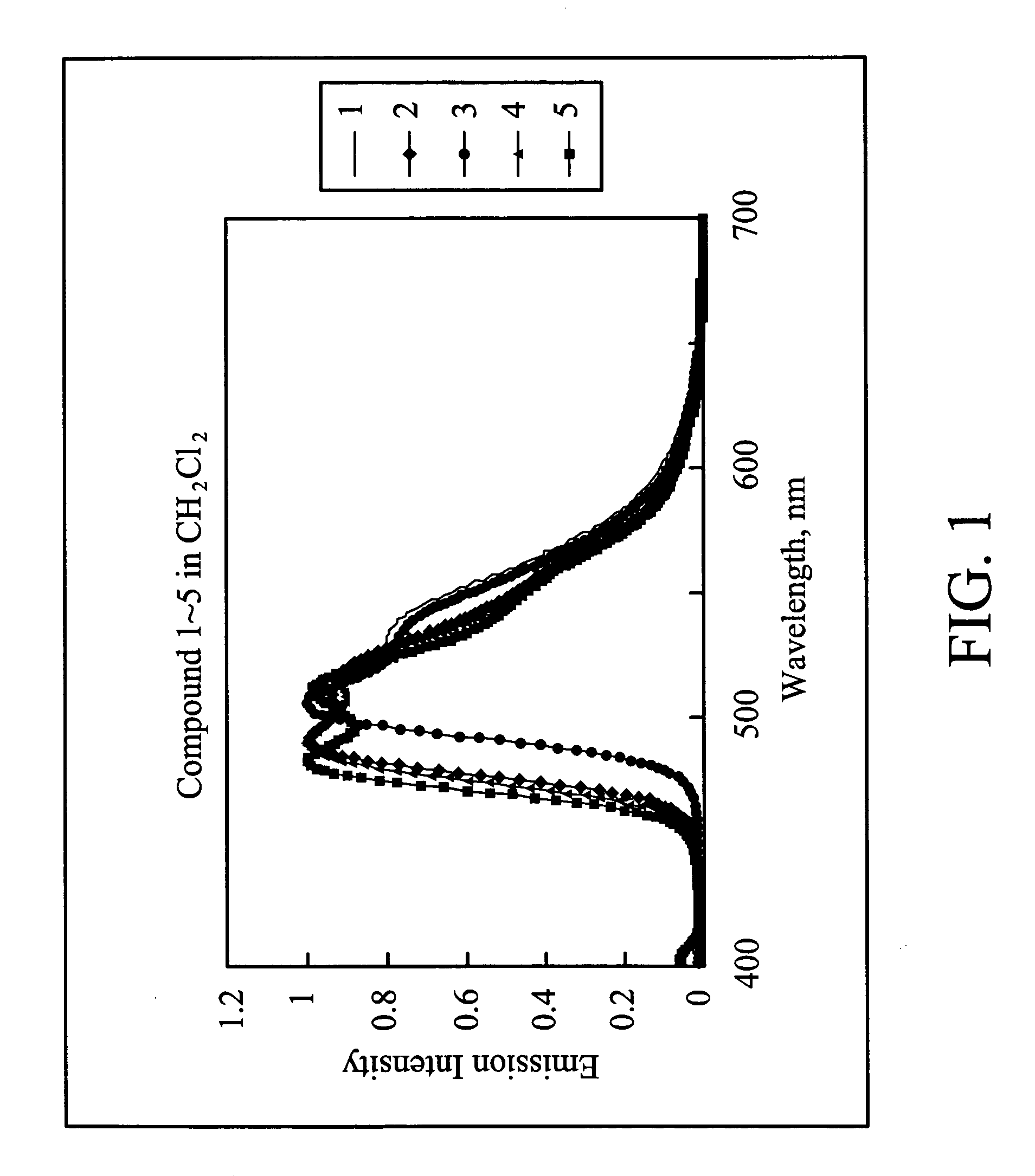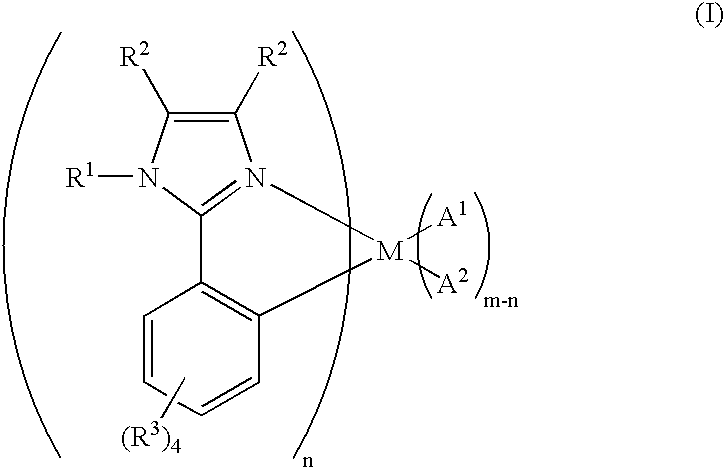Organometallic complex for organic electroluminescent device
an electroluminescent device and organic technology, applied in the field of organic electroluminescent devices containing organic metal complexes, can solve the problems of more effort in the development of organometallic complexes emitted blue light, and achieve the effect of reducing the cost of development and maintenan
- Summary
- Abstract
- Description
- Claims
- Application Information
AI Technical Summary
Problems solved by technology
Method used
Image
Examples
example 1
Synthesis of iridium(III)bis[1,2-diphenyl-1H-benzoimidazole](picolinate) (Compound 1)
[0033]The synthesis pathway is shown below.
[0034]Step 1: 40 ml of N-phenyl-1,2-phenylenediamine (7.36 g, 40 mmol) was charged in a 250 ml round bottle, 10 ml of triethylamine was then added, and the mixture was cooled to 0° C. Benzoyl chloride (5.6 g, 40 mmol) was dissolved in 40 ml of dichloromethane and then slowly added to the 250 ml round bottle. The reaction was conducted under a nitrogen atmosphere for 6 hours. After the reaction was complete, ether was added to form precipitation. The solid product was collected by filtration, washed with ether several times, and heated under reduced pressure to form 1,2-diphenyl-1H-benzoimidazole (yield=7.56 g, 70%).
[0035]Step 2: 1,2-diphenyl-1H-benzoimidazole (6.75 g, 25 mmol) and iridium(III) chloride trihydrate (4.2 g, 12 mmol) were mixed and then a mixed solution containing 60 ml of ethyoxyethanol and 20 ml of water was added. The mixture was heated to ...
example 2
Synthesis of iridium(III)bis[2-(4-Fluorophenyl)-1-phenyl-1H-benzoimidazole](picolinate) (Compound 2)
[0037]Step 1: N-phenyl-1,2-phenylenediamine (1.84 g, 10 mmol) and 30 ml of dichloromethane were charged in a 250 ml round bottle, 3 ml of triethylamine was then added, and the mixture was cooled to 0° C. 4-Fluoro-benzoyl chloride (1.58 g, 10 mmol) was dissolved in 30 ml of dichloromethane and then slowly added to the 250 ml round bottle. The reaction was conducted under a nitrogen atmosphere for 6 hours. After the reaction was complete, ether was added to form precipitation. The solid product was collected by filtration, washed with ether several times, and heated under reduced pressure to form 2-(4-fluoro-phenyl)-1-phenyl-1H-benzoimidazole (yield=2.3 g, 80%).
[0038]Step 2: 2-(4-fluoro-phenyl)-1-phenyl-1H-benzoimidazole (2.3 g, 8 mmol) and iridium(III) chloride trihydrate (1.41 g, 4 mmol) were mixed and then a mixed solution containing 30 ml of ethyoxyethanol and 10 ml of water was add...
example 3
Synthesis of iridium(III)bis[2-(2-Fluorophenyl)-1-phenyl-1H-benzoimidazole](picolinate) (Compound 3)
[0040]Step 1: N-phenyl-1,2-phenylenediamine (3.68 g, 20 mmol) and 40 ml of dichloromethane were charged in a 250 ml round bottle, 5 ml of triethylamine was then added, and the mixture was cooled to 0° C. 2-Fluoro-benzoyl chloride (3.16 g, 20 mmol) was dissolved in 40 ml of dichloromethane and then slowly added to the 250 ml round bottle. The reaction was conducted under a nitrogen atmosphere for 6 hours. After the reaction was complete, ether was added to form precipitation. The solid product was collected by filtration, washed with ether several times, and heated under reduced pressure to form 2-(2-fluoro-phenyl)-1-phenyl-1H-benzoimidazole (yield=4.32 g, 75%).
[0041]Step 2: 2-(2-fluoro-phenyl)-1-phenyl-1H-benzoimidazole (4.03 g, 14 mmol) and iridium(III) chloride trihydrate (2.47 g, 7 mmol) were mixed and then a mixed solution containing 30 ml of ethyoxyethanol and 10 ml of water was ...
PUM
| Property | Measurement | Unit |
|---|---|---|
| Transport properties | aaaaa | aaaaa |
| Phosphorescence quantum yield | aaaaa | aaaaa |
Abstract
Description
Claims
Application Information
 Login to View More
Login to View More - R&D
- Intellectual Property
- Life Sciences
- Materials
- Tech Scout
- Unparalleled Data Quality
- Higher Quality Content
- 60% Fewer Hallucinations
Browse by: Latest US Patents, China's latest patents, Technical Efficacy Thesaurus, Application Domain, Technology Topic, Popular Technical Reports.
© 2025 PatSnap. All rights reserved.Legal|Privacy policy|Modern Slavery Act Transparency Statement|Sitemap|About US| Contact US: help@patsnap.com



